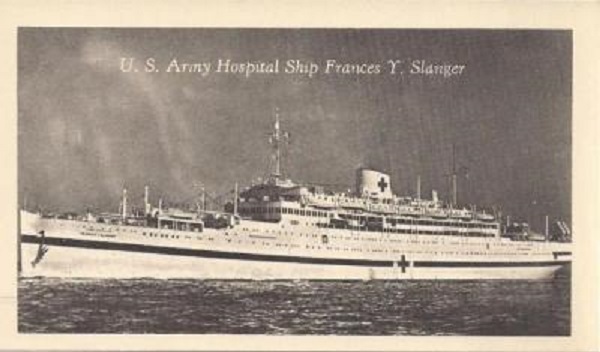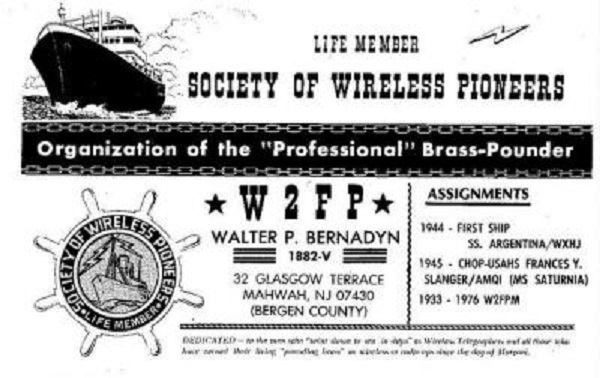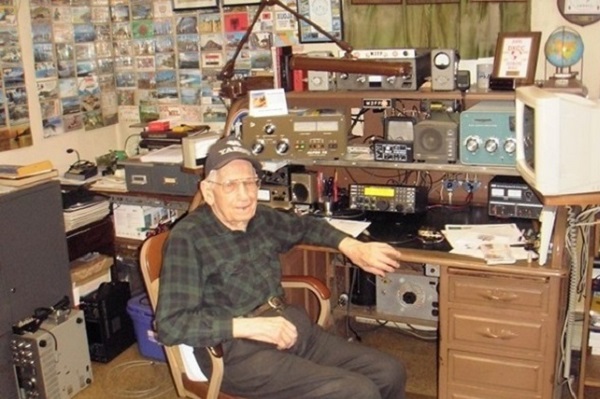 |
Walter P. 'Walt' Bernadyn Mahwah, NJ QCWA # 02918 |
W2FP is a Silent Key. He passed sometime in 2015. He is mentioned in the ARRL Board meeting minutes of July 2015.
Grateful for 75 Years of Amateur Radio
In 1933 I went to the Federal Radio Commission in New York for my radio license. I took the test and was issued my first license, W2FPM. The FCC took over later on. My first transmitter was a single 45 tube with copper tubing from Pep Boys Automotive Store. The receiver was made from parts bought at Radio Row in New York.
World War II
World War II found me getting training at M.P. replacement center in Fort Ontario, NY. QST was running an "In the Services" column so I sent in my nameto let my friends know where I was. I received a letter from Charles A. Service, Jr., Assistant Secretary of the ARRL asking me what I was doing in the Military Police and if I wanted a change to the Signal Corps, he would take care of it. With basic training, getting up at day break and drilling until dark, I never got a chance to answer him.
I am grateful for amateur radio. When I finished my basic training, I wound up on a pier in New York City. The first morning at roll call, I was told to pack my bag and I would be leaving. An officer in a Jeep came along and drove me direct to Ft. Monmouth in New Jersey. Charles A. Service and the League had done their work. Arriving at the Fort, I went from Pfc to T/5. After a few weeks in high speed code class, I was given a T/4 and shipped to the Brooklyn, New York Army Base for Ship Radio Operators.
Ships
The S.S. ARGENTINA was my first ship. I was assigned as first radio operator. We sailed in convoy from New York to Liverpool in England. I sailed on various ships. The toughest assignment was a 100 foot sea-going Tug Boat. Lucky the radio room was very small and I could keep watch on 500 KHz by bracing my foot against the bulkhead. The good part was that no self-respecting submarine would waste a torpedo on us. When I got back to New York I was able to get over to the Federal Building and get my First Class Telegraph Operator License, as I had 6 months sea time.
M.S. Saturnia, the world's largest motor ship was converted to a Hospital Ship and renamed the Francis Y. Slanger. I was assigned as chief radio operator mainly because of my amateur radio background and technical experience and promoted to a Technical Sergeant.
Morse and Blinker Operations
Knowledge of the code was essential. With radio silence during the war, most of the communication was by Blinker light. This job was supposed to be done by the ship's First Mates but they were pretty rusty on the code so this job felkl to me.
On our first trip to Southampton, England, the following headline on July 11, 1945 in the ECHO: "LUXURY LINER AS HOSPITAL SHIP CARRYING CASUALTIES FROM SOUTHAMPTON."
The former Italian luxury liner Saturnia, converted in the United States into the world's largest hospital ship, embarked 1500 American casualties at her berth in Southampton's new docks. On completion of loading, the vessel (now named the United States Army Hospital Ship Francis Y. Slanger) will make the return trip to America - her first with casualties since the conversion. The 24,470 ton 631 foot long former liner made the crossing from New York in 9 days. Her twin screws gave her a speed of approximately 19 knots.
We left the Southampton dock on July 12, 1945, headed for the English Channel but only got as far as the Isle of Wight. Up in the hills of Cowes was a bright light rapidly blinking. I was up on the signaling bridge as the radio watch did not start until we cleared the harbor. The Captain, who was on the bridge with the harbor pilot, called up to me and said, "Sparks, see what they want."
Blinker Watch Southampton Harbor
Shore Station: What ship?
Reply: USAHS Francis Y. Slanger
Shore Station: Anchor and await officers.
Reply: By what authority?
Shore Station: NCSO Cowes
Reply: Will anchor in area 25.
After pacing up and down the bridge for 55 minutes, the Captain asked me to contact the shore station.
Ship: Can you contact NCSO Cowes?
Shore Station: Send your message.
Ship: How long must Slanger wait?
Shore Station: Message for you.
Ship: Send your message.
Shore Station: To Slanger from NCSO Cowes - A message from U.S. Navy in Southampton - Please wait for officers to be on board at 0755.
Except for the Signal Corps radio operators, the crew on Army Hospital Ships were Merchant Marine and civilians. When a motor launch finally pulled up to the ship, it had three of the ship's mess boys, dressed up in officers uniforms to impress the girls in Southampton and evidently they also impressed the U.S. Navy.
To put it mildly, the Captain was furious and had them put in the brig to be court marshalled when we got back to New York. I had to make a full report of the Blinker Watch. However, when we got back to New York, the Captain had cooled off and he figured the mess boys had also cooled off in the brig and the charges were dropped.
We headed out to the English Channelwhere I had to send numerous safety messages (TTT TTT TTT DE AMQI, FLOATING MINE SIGHTED." and give the position. As a hospital ship we did not have to keep radio silence and we had no guns on board to blow up mines. AMQI was the call sign of the Slanger.
At the end of the war, the signal corps radio operators were replaced by civilians and I was assigned as Chief Transmitter Technician at station WVP located on Governors Island, NY. This included maintenance of 8 transmitters ranging from two kilowatts to 300 watts, and the transmitting antenna system.
Back home, I spent a considerable amount of time in CW nets handling Asian War traffic. When I received a message from my local area and a phone number, I would call and try to calm don the party. Most were very excited to hear of sons or relatives in the was zone. I asked them to write the message down and I would send them a Radiogram by mail. Most people wanted to know how I got the message and if there was any charge for the service. The Radiogram would take care of that.
Other people were grateful for amateur radio, too. I saved the following letter that I received after sending one of my Radiograms. This was sent to me but it was really meant for all the operators across the country who relayed the message.
March 28, 1957
Dear Sirs:
I received my Radiogram today. How happy I was to know my son was OK. We were afraid he was on the plane that crashed. Thank the Lord he is OK. Thanks again for my Radiogram.
Yours truly,
Mrs. Alice Bass
When all else fails, Amateur Radio is there. This is what Amateur Radio is all about
Society of Wireless Pioneers
Walter Bernadyn, W2FP is a LIfe Memer of the Society of Wireless Pioneers. He was awarded the #1 Honor Roll plaque for Top of The Honor Roll Phone and CW Mixed.
Walt submitted a wonderful personal experience relating to his long career in both the military and in amateur radio. We are printing this story exactly as Walt sent it to us.
Stolen from the North Jersey DX Association website, tnx Guys!


